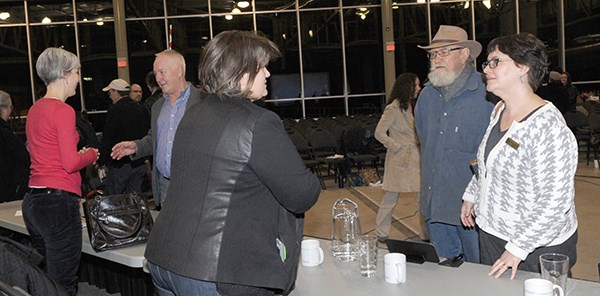Questions remain unanswered after long meetings by the volunteers on Squamish’s community committee about the planned liquefied natural gas plant.
The committee on Feb. 25 reported to district council the answers to some concerns about the proposed plant, but the group will continue to meet to seek out answers to issues including fracking, health effects and potential impact to the community’s branding as an adventure and recreation destination.
The committee, whose expenses were covered by Woodfibre LNG but did not include Woodfibre staff members, had sought out experts to provide answers about the proposed facility. Committee members included people with strong opinions for or against LNG.
“They contributed a huge amount of time, with the meetings lasting three hours in the evenings, some longer,” said committee facilitator Catherine Rockandel.
Some of the key issues that concerned the group included “fracking and impact on the Squamish brand,” she said, but the committee was unable to find experts willing to give testimony on fracking or branding.
And the group also did not find answers to its concerns about the potential health impacts. Vancouver Coastal Health is part of the LNG working group, so their representatives “declined to speak to the committee,” Rockandel said.
The committee was concerned about a wide range of issues, including air emissions and greenhouse gases, effects of seawater cooling, marine noise pollution, economic benefit if workers are bussed in from the Lower Mainland instead of being hired locally, and the capacity of government officials to monitor the plant.
Some of the answers were found in Woodfibre’s plans, but Rockandel said the huge document with more than 10,000 pages “can be overwhelming.”
Mayor Patricia Heintzman asked if there were issues that the committee wanted to investigate.
“The committee really wanted to look at the tourism brand,” Rockandel said, but when experts who might have been able to speak were approached, “they just didn’t want to get involved.”
District engineering director Rod MacLeod, who served on the committee, said the committee did find answers regarding LNG tanker traffic in Howe Sound. Forty tankers a year are expected to make 80 trips, accompanied by tug boats, and the channel is not considered narrow, he said.
Some were also worried about potential disaster from seismic activity at the plant’s site in the wake of the Feb. 14 earthquake that shook Squamish.
Councillor Peter Kent questioned what would happen if there was seismic activity, given that the plant and a Fortis pipeline to serve it will be built on a fault line.
MacLeod responded that the committee did not look at possible effects of seismic activity but it would be discussed with council.
“The committee is volunteers and they couldn’t look at everything,” explained Rockandel, who added that the group was asked to volunteer for eight meetings and had 16 to date. “It’s much more than they signed up for.”
At the Feb. 25 public meeting, people in the audience asked questions about various issues, including air quality, possible shipping dangers, effects on the Squamish estuary, the district’s monitoring of the site, hydro, fracking, tanker traffic in Howe Sound, the proximity of the FortisBC natural gas pipeline to homes, and the Woodfibre LNG seawater cooling system and its effects on sea life.
Councillor Jason Blackman-Wulff noted a lot of the discussion is about “fear of the unknown,” and he questioned how much staff time is being devoted to this committee. “As a municipality, we are facing serious budget pressures due to the erosion of our tax base,” he said.
Councillor Susan Chapelle said although some are questioning impacts on fish, “also think of people dying in China” due to pollution. The liquefied natural gas is to be exported to Asia.
“I consider it a clean-burning energy that will help people get out of their situation,” said Chapelle.
The community committee includes Antony Blaikie, Sean Carron, Councillor Karen Elliott, Linda Kelly-Smith of Squamish Climate Action Network, Karine Le Du, district engineering director Rod MacLeod, Chris Pettingill of the Squamish Chamber of Commerce, Councillor Doug Race, Jennifer Reilly, Glenn Stainton, Sara Van Mulligen, Donna Wall of Tourism Squamish and Richard Wildman Jr.



